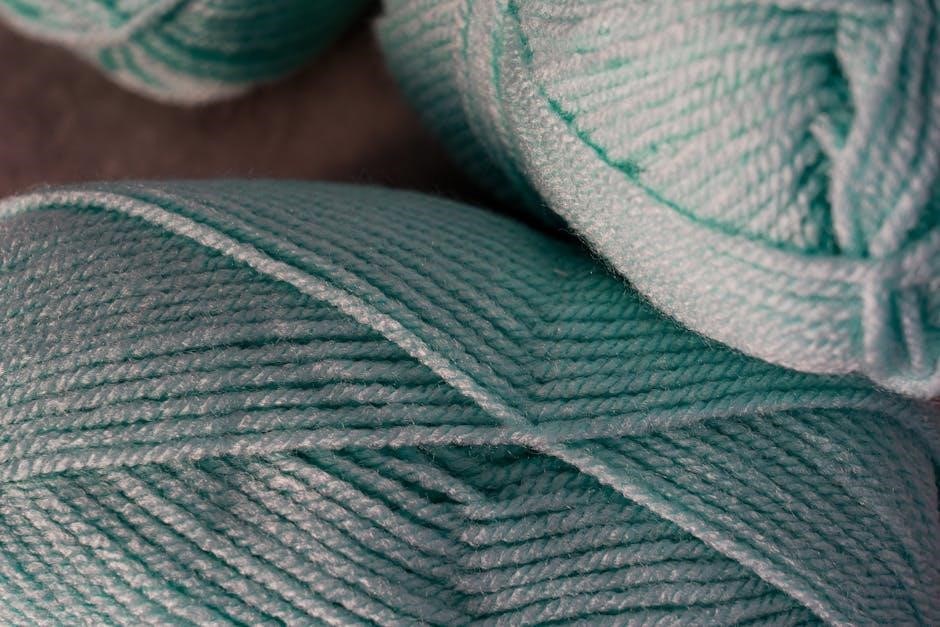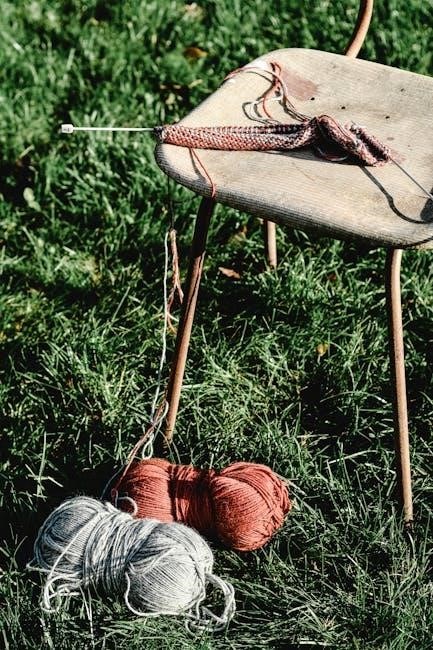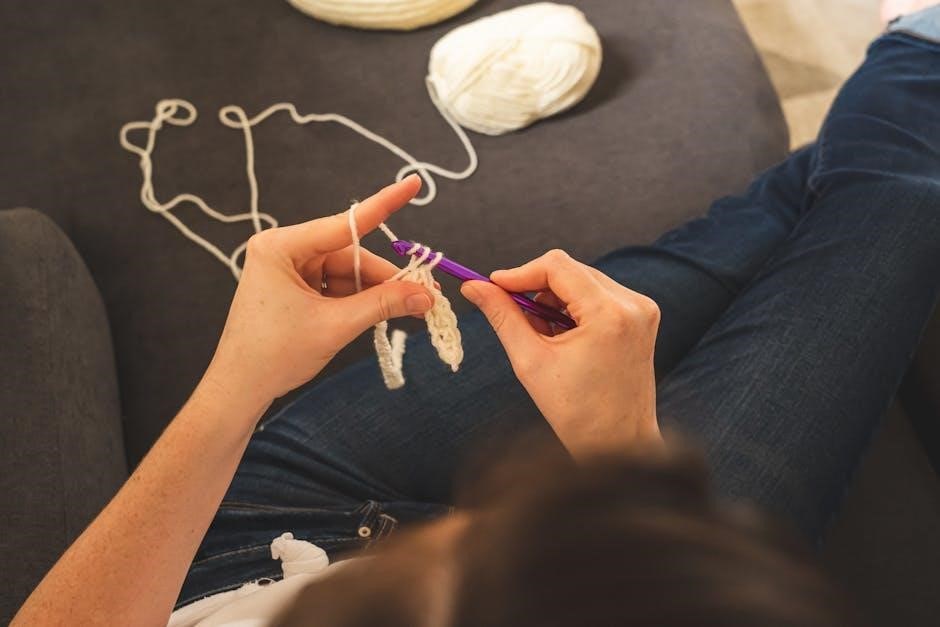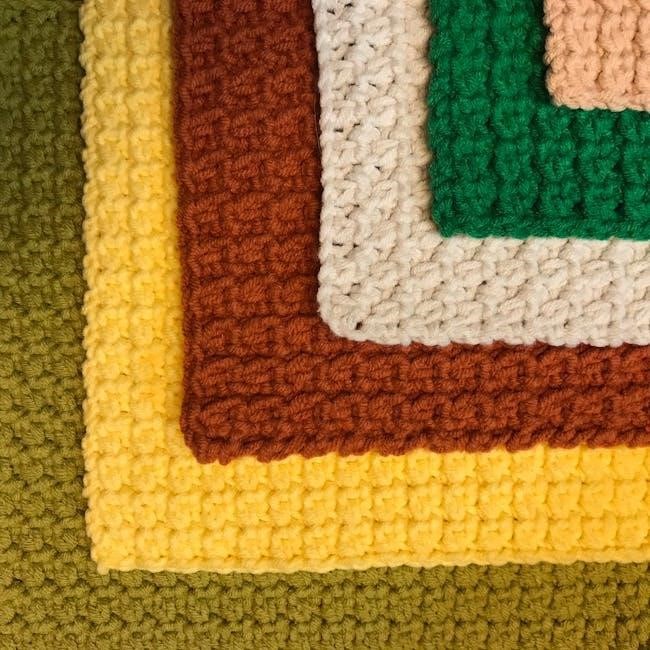Crochet Basic Stitches PDF: A Comprehensive Guide
Embark on your crochet journey with our comprehensive guide! This resource provides essential knowledge and skills‚ downloadable in PDF format․ Learn fundamental stitches‚ understand patterns‚ and access free resources․ Master the basics and unlock endless creative possibilities․ Let’s crochet!
Crochet‚ a craft of looping yarn with a hook‚ offers a gateway to creativity and relaxation․ This guide introduces the basics‚ perfect for beginners eager to embark on their crochet journey․ Discover the joy of transforming simple strands into beautiful fabrics and intricate designs․
We’ll explore essential materials‚ from selecting the right crochet hook to choosing beginner-friendly yarn․ Master fundamental stitches like chain stitch‚ single crochet‚ double crochet‚ and half-double crochet․ Learn to read crochet charts‚ unlocking a world of patterns and projects․
This guide also provides free crochet patterns in PDF format‚ allowing you to practice your new skills․ Get expert tips and tricks for mastering basic stitches‚ ensuring a solid foundation for more advanced techniques․ Whether you dream of creating cozy blankets‚ stylish accessories‚ or charming amigurumi‚ this comprehensive resource will set you on the path to crochet success․
Join a community of like-minded crocheters‚ share your creations‚ and find inspiration for your next project․ Let’s begin this exciting adventure together!
Essential Crochet Materials
Before diving into the world of crochet stitches‚ it’s crucial to gather the right materials․ These tools will set the stage for a successful and enjoyable crafting experience․ The two main components are crochet hooks and yarn‚ each available in various sizes and types to suit different projects․
Crochet hooks come in a range of sizes‚ typically measured in millimeters or using a letter/number system․ Choosing the appropriate hook size depends on the yarn weight and desired stitch definition․ For beginners‚ a G/6 (4․00 mm) or H/8 (5․00 mm) hook is a great starting point‚ working well with medium-weight yarns․
Yarn selection is equally important․ Beginners should opt for smooth‚ light-colored yarns like cotton or acrylic‚ making it easier to see the stitches․ Avoid fuzzy or novelty yarns initially‚ as they can obscure stitch definition and make learning more challenging․
In addition to hooks and yarn‚ consider having scissors‚ stitch markers‚ and a yarn needle on hand․ These tools will aid in cutting yarn‚ marking specific stitches‚ and weaving in loose ends․ With the right materials‚ you’ll be well-equipped to tackle your first crochet project․

Crochet Hooks: Sizes and Selection
Selecting the right crochet hook is paramount for comfortable and successful crocheting․ Hooks come in various sizes‚ typically denoted in millimeters (mm) and/or by a letter or number․ The ideal hook size depends largely on the yarn weight you intend to use․ Thicker yarns generally require larger hooks‚ while thinner yarns pair well with smaller hooks․
Beginners often find it helpful to start with a medium-sized hook‚ such as a 4․0mm (G/6) or 5․0mm (H/8)․ These sizes are versatile and work well with worsted-weight yarn‚ a common and readily available yarn type․ When choosing a hook‚ consider the material as well․ Aluminum hooks are smooth and affordable‚ while ergonomic hooks with cushioned handles can reduce hand fatigue during longer projects․
It’s also beneficial to have a range of hook sizes in your toolkit․ As you experiment with different yarns and projects‚ you’ll discover which hook sizes you prefer for various stitch patterns and desired fabric densities․ Don’t hesitate to consult yarn labels‚ which often suggest a recommended hook size for optimal results․ Proper hook selection is key to achieving consistent and beautiful crochet work․
Yarn Types for Beginners

Choosing the right yarn is crucial for a beginner’s success in crochet․ Several factors influence yarn selection‚ including fiber content‚ weight‚ and texture; For beginners‚ worsted-weight yarn is often recommended due to its ease of handling and clear stitch definition․ This yarn weight works well with a variety of hook sizes and is suitable for many beginner-friendly projects․
Cotton yarn is another excellent choice for beginners․ It’s durable‚ washable‚ and doesn’t stretch easily‚ making it forgiving for those learning new stitches․ Acrylic yarn is also popular due to its affordability and wide range of colors․ However‚ it can sometimes be more slippery than cotton‚ which may pose a slight challenge for beginners․
Avoid novelty yarns with fuzzy or textured surfaces when starting out‚ as they can obscure stitch definition and make it difficult to see your work․ Opt for smooth‚ solid-colored yarns to help you clearly see each stitch and practice consistent tension․ As you gain experience‚ you can explore different yarn types and textures to add variety and complexity to your projects․ Remember‚ the goal is to find a yarn that feels comfortable in your hands and allows you to focus on mastering the basic crochet stitches․
Basic Crochet Stitches

Mastering basic crochet stitches is the foundation for creating beautiful and intricate projects․ These essential stitches‚ once learned‚ will enable you to read patterns and confidently tackle various crochet designs․ The primary stitches every beginner should learn include the chain stitch (ch)‚ single crochet (sc)‚ double crochet (dc)‚ and half double crochet (hdc)․
The chain stitch forms the basis of most crochet projects‚ serving as the foundation row or round․ The single crochet is a tight‚ compact stitch ideal for creating dense fabrics and amigurumi․ The double crochet is taller than the single crochet‚ producing a looser fabric with more drape․ Lastly‚ the half double crochet offers a middle ground between single and double crochet‚ creating a textured fabric that’s not too tight or too loose․
Understanding how to create these stitches consistently and correctly is key to achieving neat and even results․ Practice each stitch individually‚ focusing on maintaining consistent tension and proper stitch placement․ With patience and persistence‚ you’ll develop the muscle memory needed to execute these stitches smoothly and efficiently‚ opening the door to a world of crochet possibilities․
Chain Stitch (ch)
The chain stitch‚ often abbreviated as “ch‚” is the very first stitch you’ll learn in crochet and serves as the foundation for almost all projects․ It’s used to create the initial row or round upon which other stitches are built․ Mastering the chain stitch is crucial for establishing the correct width or circumference of your work․
To begin‚ create a slip knot on your hook‚ ensuring it sits securely․ Then‚ yarn over (wrap the yarn around the hook) and pull the yarn through the loop on your hook․ This creates your first chain stitch․ Repeat the process – yarn over and pull through the loop – to create a chain of the desired length․
Maintaining consistent tension is key to creating even chain stitches․ Avoid pulling the yarn too tightly‚ which can make it difficult to work into the chain later․ Practice creating chains of varying lengths‚ focusing on achieving uniform stitch size․ The chain stitch is also used to create spaces between stitches‚ adding decorative elements to your crochet designs․ With practice‚ you’ll find the chain stitch becomes second nature‚ setting the stage for more complex crochet techniques․
Single Crochet (sc)
The single crochet (sc) stitch is a fundamental and compact stitch‚ often the next one learned after the chain stitch; It creates a dense fabric‚ making it ideal for projects requiring sturdiness and minimal gaps‚ such as amigurumi‚ blankets‚ and bags․ It’s an excellent choice for beginners due to its simplicity and the firm structure it provides․
To execute a single crochet‚ begin by inserting your hook into the second chain from the hook (or the designated stitch in a row)․ Yarn over‚ and pull the yarn through the stitch‚ resulting in two loops on your hook․ Next‚ yarn over again and pull the yarn through both loops․ This completes the single crochet stitch‚ leaving one loop on your hook․
Consistency in tension is vital for achieving uniform single crochet stitches․ Keep your tension even to prevent the fabric from becoming too tight or too loose․ The single crochet stitch is often used in rows‚ and at the end of each row‚ you’ll typically chain one and turn your work before beginning the next row of single crochet stitches․ With practice‚ the single crochet stitch becomes a cornerstone of your crochet skills‚ allowing you to create a wide variety of projects․
Double Crochet (dc)
The double crochet (dc) stitch is another essential stitch in crochet‚ creating a taller and looser fabric compared to the single crochet․ It’s frequently used in projects like scarves‚ blankets‚ and garments‚ offering a good balance between speed and texture․ Mastering the double crochet opens up a wide range of pattern possibilities․
To begin a double crochet‚ yarn over your hook․ Insert your hook into the designated stitch․ Yarn over again‚ and pull the yarn through the stitch‚ leaving three loops on your hook․ Yarn over once more‚ and pull the yarn through the first two loops on your hook‚ leaving two loops remaining․ Finally‚ yarn over and pull the yarn through the last two loops‚ completing the double crochet stitch and leaving one loop on your hook․
At the end of a double crochet row‚ you usually chain two or three (depending on the pattern and desired edge height) before turning your work․ Maintaining consistent tension is key to even double crochet stitches; The double crochet stitch is a versatile stitch‚ and its height makes it quicker to work up projects than single crochet․ It can also be combined with other stitches to create interesting textures and patterns‚ making it a valuable addition to your crochet repertoire․ With practice‚ you will become proficient in this essential technique․
Half Double Crochet (hdc)
The half double crochet (hdc) stitch is a versatile stitch that falls between the single crochet (sc) and double crochet (dc) in terms of height and texture․ It creates a denser fabric than double crochet‚ but works up faster than single crochet‚ making it a popular choice for many crochet projects‚ including hats‚ scarves‚ and afghans․
To work a half double crochet stitch‚ begin by yarning over the hook․ Insert the hook into the designated stitch․ Yarn over again‚ and pull the yarn through the stitch․ This will leave you with three loops on your hook․ Now‚ yarn over one more time‚ and pull the yarn through all three loops on your hook in one motion․ This completes the half double crochet stitch;
When starting a new row of half double crochet‚ it is common to chain two at the end of the previous row to bring the yarn to the correct height․ The half double crochet stitch produces a fabric with a slightly textured appearance‚ making it a visually appealing choice for many projects․ The hdc is simple to execute and provides a satisfying balance of speed and density‚ making it an excellent stitch for both beginners and experienced crocheters alike․ Practice this stitch to master its unique qualities and incorporate it into a variety of patterns․
How to Read Crochet Charts
Crochet charts are visual representations of crochet patterns‚ offering an alternative to written instructions․ They use symbols to represent different stitches‚ making it easier to understand the overall structure of a project at a glance․ Learning to read these charts can significantly expand your ability to tackle complex patterns and designs․
Each symbol on a crochet chart corresponds to a specific stitch․ Common symbols include a “T” shape for double crochet‚ a “+” shape for single crochet‚ and an oval or circle for chain stitches․ The chart is read from bottom to top‚ representing the rows of the crochet project․ Arrows indicate the direction in which each row should be worked‚ with right-handed crocheters typically working from right to left‚ and left-handed crocheters working from left to right․
Understanding the key or legend accompanying the chart is crucial‚ as it identifies the stitch each symbol represents․ Pay attention to any special instructions or repetitions indicated on the chart․ Some charts use color-coded symbols to differentiate between sections or stitch types․ With practice‚ you’ll become proficient at recognizing these symbols and interpreting the charts‚ enabling you to confidently create intricate crochet designs․ Crochet charts are a valuable skill for any crocheter․
Free Crochet Patterns for Beginners (PDF Downloads)
Embark on your crochet journey with our curated selection of free crochet patterns specifically designed for beginners! These patterns are available as convenient PDF downloads‚ allowing you to easily access and print them for your crafting sessions․ Each pattern includes clear‚ step-by-step instructions‚ making it simple for newcomers to learn basic crochet techniques․
Our collection features a variety of beginner-friendly projects‚ such as scarves‚ dishcloths‚ and simple blankets․ These projects utilize basic crochet stitches like chain stitch‚ single crochet‚ and double crochet‚ providing ample opportunity to practice and master these essential skills․ The PDF downloads often include helpful diagrams and stitch guides‚ ensuring that you have all the resources you need to succeed․
Explore our selection of free crochet patterns and discover the joy of creating handmade items․ With easy-to-follow instructions and readily available PDF downloads‚ you’ll be crocheting beautiful projects in no time! These free resources are perfect for building your confidence and expanding your crochet skills․ Don’t hesitate to start your crochet adventure today with these fantastic patterns!

Tips and Tricks for Mastering Basic Stitches
Mastering basic crochet stitches is crucial for any beginner․ Here are some essential tips and tricks to help you on your journey! First‚ maintain consistent tension․ This will ensure your stitches are uniform and your project looks neat․ Practice each stitch repeatedly until you feel comfortable with the motion․ Don’t be afraid to frog (rip out) your work if you make a mistake; it’s part of the learning process!
Pay attention to your yarn and hook size․ Using the recommended size for your yarn will make a huge difference․ Also‚ try different hook sizes with the same yarn to see what you prefer․ Understanding stitch anatomy is key․ Know where to insert your hook for each stitch to avoid creating extra or missing stitches․
Watch video tutorials for visual guidance․ Many crocheters find it helpful to see the stitches being worked in real-time․ Finally‚ join a crochet community! Sharing tips and asking questions can provide invaluable support․ With patience and practice‚ you’ll master these basic stitches in no time‚ opening up a world of crochet possibilities․